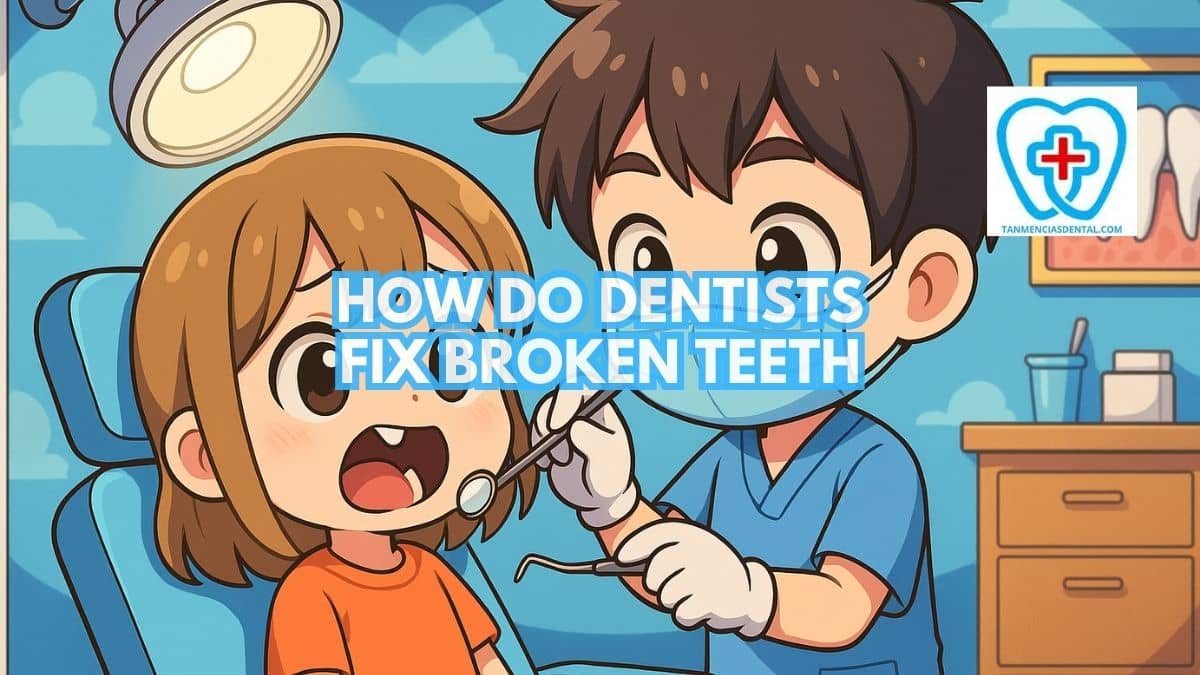Broken teeth can happen from accidents, decay, or biting hard foods.
Dentists use different tools and methods based on the type and extent of the damage.
We’ll explain how they fix broken teeth step by step.
The choice of treatment depends on how deep the crack goes or how large the break is.
Some solutions are simple and quick, while others need more time and care.
1. Comprehensive Dental Examination And X-Ray Analysis
Dentists begin by examining the tooth closely and asking about how it broke.
X-rays help them see inside the tooth and check for cracks, decay, or infection in places they can’t see with their eyes.
This step is important to understand how much of the tooth is still healthy.
It also shows if the root or surrounding bone has been affected.
Based on these results, the dentist can choose the best way to repair the damage.
🦷 How Long Do Teeth Cleanings Take?
2. Tooth-Colored Composite Fillings For Minor Repairs
Small cracks or shallow damage can often be fixed with composite fillings.
These fillings are made from a tooth-colored material that blends in with the natural tooth.
The dentist cleans the area, applies the filling, and uses a curing light to harden it.
This type of repair is quick and usually done in one visit.
It seals the damaged area and helps protect the tooth from further harm.
🦷 How Long After Brushing Teeth Can I Use White Strips?
3. Composite Resin Bonding For Small Chips
Composite bonding is used to fix small chips, especially on front teeth.
The dentist applies a bonding agent and layers of resin, shaping it carefully to match the tooth’s form.
A special light hardens the resin, and the surface is polished to blend in.
This repair looks natural and does not take long.
It’s a good option for restoring the shape of chipped teeth.
🦷 How Fast Do Cavities Grow with Poor Brushing and Flossing?
4. Precision Inlays/Onlays For Moderate Damage
Inlays and onlays are used when a filling isn’t strong enough, but a crown isn’t necessary.
An inlay fits inside the tooth’s grooves, while an onlay also covers one or more of its edges.
They are made from strong materials like porcelain or resin and are created in a lab.
The dentist prepares the tooth, takes an impression, and places the piece once it’s ready.
These restorations are durable and offer a precise fit.
🦷 How Long Does It Take for Cavities to Form?
5. Custom Dental Crowns For Extensive Fractures
Crowns are needed when a large part of the tooth is missing or weak.
The dentist reshapes the tooth and makes a mold for a custom crown.
While waiting for the final crown, a temporary one is placed for protection.
Permanent crowns are made from metal, ceramic, or porcelain and are designed to match your other teeth.
Once cemented, they restore full function and appearance.
🦷 How Do You Fix A Chipped Tooth?
6. Porcelain Veneers For Cosmetic Restoration
Porcelain veneers are used for teeth that are chipped but otherwise healthy.
These thin shells cover only the front surface of the tooth.
The dentist removes a small layer of enamel so the veneer fits correctly.
Each veneer is custom-made and bonded to the tooth.
They are often used for cosmetic repairs to front teeth, where appearance matters most.
🦷 Brushing for Better Gums: Unveiling the Best Toothpastes for Gingivitis
7. Root Canal Therapy For Exposed Pulp Damage
A deep crack can expose the pulp, which contains nerves and blood vessels.
If this happens, a root canal is needed to remove the damaged tissue.
The inside of the tooth is cleaned, filled, and sealed to prevent infection.
This saves the tooth and relieves pain.
A crown is often added afterward to protect the tooth.
🦷 How Meals After Wisdom Teeth Removal Can Speed Up Your Recovery
8. Tooth Extraction With Implant Replacement
If a tooth cannot be saved, the dentist will remove it.
After the area heals, an implant can be placed to replace the missing tooth.
The implant acts as an artificial root and holds a crown in place.
This replacement looks and functions like a natural tooth.
It also helps maintain jawbone strength and keeps nearby teeth in place.
🦷 How Long Does It Take To Brush Your Teeth White?
9. Emergency Temporary Stabilization Solutions
In some cases, a dentist needs to stabilize the tooth right away.
They may use temporary materials like soft fillings or crowns to hold the tooth together.
This helps ease pain and stop further damage while waiting for a final solution.
Temporary fixes are helpful in urgent situations or when lab-made parts are still being prepared.
Though short-term, they play a key role in managing dental emergencies.
🦷 How Long Do Electric Toothbrushes Last?
10. Edge Smoothing And Enamel Polishing
Tiny chips or sharp edges can be smoothed without much work.
The dentist uses tools to gently polish the tooth’s surface.
This makes the tooth feel better and removes any rough spots that could cut your mouth.
It’s a simple process that usually doesn’t need numbing.
The result is a smoother, safer, and cleaner-looking tooth.
🦷 Marikina City Family Oral Health Clinic
👨⚕️ Conclusion
Dentists use many methods to fix broken teeth, depending on the damage.
Quick treatments like fillings or bonding work for small issues, while bigger problems need crowns, veneers, or implants.
Each method helps restore how the tooth works and how it looks.
Repairing a broken tooth can also stop pain, protect other teeth, and prevent infections.
Early treatment gives the best results and helps keep your smile healthy.
😊 Self-Promotion
Visit us at Tan-Mencias Dental Clinic, located at 44 G. Del Pilar Street, Parang, Marikina City.
We’re here to help you with any tooth problems, big or small.
You can call us at 9171451074, message us on our Facebook page, or reach out through the contact section on our website.
Our friendly team is ready to answer your questions and make sure you feel comfortable.
We’d love to help you keep your smile healthy and bright!

